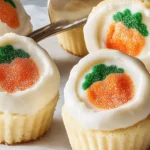These delightful Japanese fish-shaped pastries are filled with sweet or savory fillings and feature a crispy exterior with a fluffy, cake-like interior. Perfect for dessert or a fun snack, Taiyaki can be customized with a variety of fillings like red bean paste, custard, chocolate, or even cheese.
FULL RECIPE
Ingredients
- 1 cup all-purpose flour
- 1/2 tsp baking powder
- 1 tbsp cornstarch
- 1 tbsp sugar
- 1 egg
- 3/4 cup milk
- 1/2 tsp vanilla extract
- 1 tbsp vegetable oil (plus more for greasing mold)
- 1/2 cup sweetened red bean paste or filling of choice (custard, Nutella, etc.)
Directions
- In a bowl, mix flour, baking powder, cornstarch, and sugar.
- In another bowl, whisk egg, milk, vanilla, and 1 tablespoon of oil until smooth.
- Combine wet and dry ingredients until you get a smooth batter.
- Preheat a Taiyaki pan and lightly oil both sides.
- Pour a small amount of batter into one side of the mold, spreading it to cover the surface.
- Add a spoonful of your chosen filling in the center.
- Cover with more batter to seal the filling.
- Close the pan and cook on medium heat for 2–3 minutes per side, or until golden and crispy.
- Remove Taiyaki and serve warm.
Nutritional Information
- Calories: 180
- Carbohydrates: 28g
- Protein: 4g
- Fat: 5g
- Sugar: 10g
- Fiber: 1g
Origins of Taiyaki
Taiyaki is a traditional Japanese street food that dates back to the early 20th century. Originally inspired by imagawayaki, a round, filled pancake, Taiyaki gained popularity for its whimsical fish shape, modeled after the tai (red seabream), a symbol of good luck in Japanese culture. This evolution of form and presentation helped distinguish Taiyaki as a beloved staple in Japanese snack cuisine.
Cultural Significance
Taiyaki is more than just a snack—it’s a cultural icon in Japan. Found at festivals, food stalls, and specialty shops, it evokes nostalgia and joy, especially among those who associate it with childhood memories. Its presence in anime and Japanese pop culture has further cemented its status as a national favorite.
Modern Variations
Today’s Taiyaki comes in many forms, from traditional red bean paste to trendy modern fillings like Nutella, custard, and even savory versions with cheese or sausage. Some versions use croissant dough or mochi flour for a twist in texture, offering consumers a broad range of experiences beyond the classic recipe.
Taiyaki Pan and Tools
A key element in making Taiyaki is the specialized fish-shaped mold, known as a Taiyaki pan. These pans are available in stovetop or electric versions. The use of cast iron is traditional and offers a crispier shell, but non-stick electric models have made the treat more accessible to home cooks worldwide.
Taiyaki vs. Bungeoppang
Taiyaki has a close Korean cousin known as bungeoppang. While both are similar in appearance and basic construction, bungeoppang tends to use a slightly different batter, often with a crispier finish. The cultural contexts and available fillings also vary slightly, making each version a unique regional interpretation.
Texture and Taste Experience
A perfect Taiyaki has a delightful contrast between its crispy, golden-brown exterior and soft, slightly chewy interior. When freshly cooked, the warmth of the filling combined with the texture of the batter creates an irresistible balance that appeals to a wide audience.
Popular Fillings
Traditional Taiyaki uses sweetened red bean paste (anko), but over the years, many fillings have gained popularity. Custard, chocolate, matcha cream, sweet potato, and fruit jams are commonly used for sweet versions. On the savory side, cheese, ham, curry, and even pizza-style fillings are increasingly common.
Taiyaki as a Dessert Trend
Taiyaki has gained international recognition, especially in dessert cafes across Asia, North America, and Europe. Often served with soft-serve ice cream emerging from its mouth, it has become a social media sensation due to its cute appearance and indulgent fillings.
Seasonal and Festive Versions
Many shops in Japan and abroad offer limited-time or seasonal Taiyaki, such as pumpkin-flavored fillings in autumn or strawberry versions in spring. These variations keep customers engaged and introduce new flavor experiences throughout the year.
Nutrition and Dietary Considerations
While Taiyaki is a treat, it can be adapted to various dietary needs. Whole wheat flour or low-sugar fillings can be used for a healthier version. Vegan options are also possible by using plant-based milk and egg substitutes, making Taiyaki accessible to those with dietary restrictions.
Serving Suggestions
Taiyaki is typically enjoyed warm, right out of the mold, but it can also be served with ice cream, whipped cream, or fruit toppings. For a café-style presentation, it’s often garnished and plated as a centerpiece dessert.
Storage and Reheating Tips
Though best fresh, Taiyaki can be stored in an airtight container in the refrigerator for up to two days. To reheat, use a toaster oven or a dry skillet to restore its crispiness. Microwaving is not recommended as it can make the pastry soggy.
Street Food to Cafe Star
Taiyaki has journeyed from a humble street food to a featured item in high-end cafes and dessert bars. Its versatility and aesthetic appeal make it perfect for customization and upscale interpretations, appealing to both traditionalists and modern foodies.
Taiyaki in Pop Culture
Taiyaki frequently appears in Japanese anime, manga, and TV shows. Characters are often seen eating Taiyaki as a snack, which has helped increase its recognition among international fans of Japanese media.
DIY Taiyaki at Home
Making Taiyaki at home has become increasingly popular with the availability of affordable molds and online tutorials. Home cooks can experiment with different batters and fillings to suit their tastes, making it a fun family activity.
Regional Differences in Japan
Various regions in Japan have their own spin on Taiyaki. For example, in Kansai, the batter is often fluffier and more pancake-like, while Tokyo-style Taiyaki is crispier. These regional nuances add depth to Taiyaki’s culinary identity.
Fusion Recipes and Innovation
Fusion Taiyaki recipes are now emerging, blending Japanese tradition with other global flavors. From matcha-chocolate swirl batters to banana-pudding fillings, chefs are pushing creative boundaries while keeping the classic shape and cooking method.
Business Potential
Taiyaki’s low production cost and high visual appeal make it a great product for small business ventures or dessert shops. It attracts customers both for its taste and Instagram-friendly presentation, offering strong potential in food truck or kiosk formats.
Sustainability and Packaging
Eco-conscious businesses are now exploring sustainable packaging for Taiyaki, especially in markets where takeout is popular. Biodegradable wrappers and reusable trays are options that align with the growing demand for environmentally friendly practices.
Conclusion
Taiyaki is much more than a fish-shaped pastry—it’s a flavorful journey through Japanese tradition, innovation, and culinary creativity. Whether enjoyed on a street corner in Tokyo or from a dessert shop in New York, Taiyaki continues to evolve while keeping its heartwarming charm. With endless flavor possibilities and cultural richness, it remains a delightful treat worth savoring in any corner of the world.






